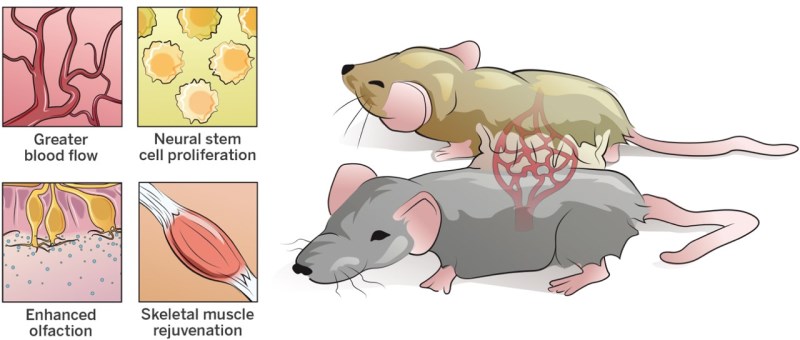Usted está aquí
Cord Blood and Anti-Aging
Does young blood hold the fountain of youth?
Can transfusions of blood from younger donors reverse or slow down the aging process in an older recipient? In experiments with mice, the answer is YES, although it is still unclear how it works, and the effect is not permanent. In 1864, the field of “Parabiosis” was invented when the physiologist Paul Bert connected two living mice so that they shared the same circulatory system. Experiments found that when a young mouse was connected to an old mouse, the old mouse was revitalized. However, mice that were connected in parabiosis typically only survived two weeks, probably due to the development of immunological rejections in each mouse against the foreign blood of the other mouse.
Within the past 20 years, researchers have been revisiting the idea of parabiosis, but now using blood transfusions between mice without surgically connecting them. In 2014, researchers at Stanford University School of Medicine found that infusions of young blood restores mental capabilities in old mice. Since then, it has become well established that giving blood from a young mouse to old mice reverses multiple symptoms of aging in their muscles and in the mouse brain. The opposite is also true, that giving blood from an old mouse to young mice triggers aging in multiple organs. But researchers do not believe that infusions of whole blood are needed to achieve this revitalization. They believe there are specific proteins or signaling factors in young blood which have this effect. For example, research groups have debated the importance and role of a protein called growth differentiation factor 11 (GDF11). The goal of the ongoing studies is to identify the specific components of young blood that can be purified as an elixir of youth.

The results from parabiosis studies in mice have inspired a series of clinical trials in humans where blood plasma from young donors is given to patients with Alzheimer’s dementia. The first publication from those trials in 2018 demonstrated that the procedure is safe. Of course, the youngest source of human blood is umbilical cord blood. The first study to give plasma from umbilical cord blood to elderly patients was published in Sept. 2022 and found that 20 biomarkers displayed beneficial changes which were statistically significant. Another study published in 2023 found that the reverse is also true, that inside the bodies of middle aged patients who received a cord blood transplant a few years ago, the blood cells from the cord blood donors aged more than twice as quickly as the elapsed time.
Commercialization of young blood
Research on young blood as a fountain of youth is inspiring a gold rush among entrepreneurs. Several start-up businesses have launched over the past few years which claim to offer anti-aging treatments by giving their paying clients the blood plasma from young donors. This has led to serious discussion about the ethics of parabiosis. If young blood can extend human longevity, then we must wrestle with the classic public health challenges of resource distribution and access disparities, as well as the new issue of how to trade off survival of older humans versus reproduction of the human race.
Within the United States, clinics that offer young blood plasma for anti-aging are taking advantage of a regulatory loophole: human blood plasma is exempted from FDA rules that prohibit organ trafficking. Hence, it is legal for young adults to sell their plasma to clinics that turn around and sell the plasma to customers. Moreover, since the benefits of young blood are temporary, prolonging those benefits requires repeat transfusions, and this makes the business even more profitable for the suppliers.
The laboratories of cord blood banks normally skim off the cord blood plasma and discard it, to reduce the volume of the sample that they will cryogenically preserve. Hence, if cord blood banks started selling their plasma for anti-aging treatments, it would literally be a case of turning waste into profits. From a regulatory perspective, selling cord blood plasma would require consent from the mothers of the cord blood donors.
In many parts of the word, anti-aging clinics have become another unregulated health service, like “stem cell clinics” which claim that they can cure whatever ails you. Anecdotally, we have heard that in some cases when mothers bank their baby’s cord blood privately, it is not for the child to use a generation from now, but for the mother to have young blood for anti-aging treatments a decade from now. By 2019, the United States FDA had already posted a consumer warning about clinics that offer young donor plasma.
Cord blood industry impact
Professionals in the cord blood industry should keep an eye on the research and commercialization around the topic of young blood for anti-aging. This is a new field which offers both potential opportunities as well as potential liability for cord blood banks. In the long run, whatever biological factors in young blood are found to have anti-aging effects, there is a good chance that cord blood banks can play a role as providers of raw material for companies that manufacture anti-aging products.


